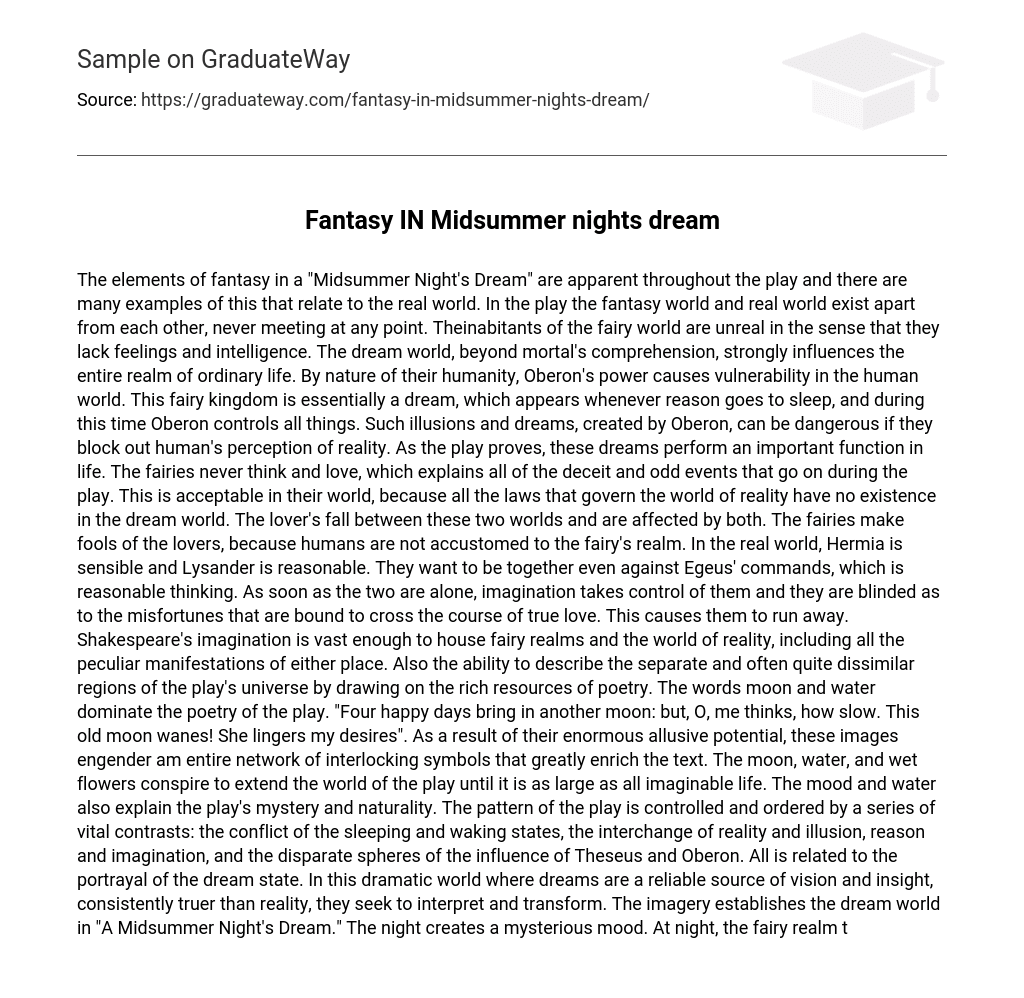The play “A Midsummer Night’s Dream” is filled with elements of fantasy that can be seen throughout the entire story. These fantastical aspects have connections to the real world. However, it’s important to note that in this play, the fantasy and real worlds remain separate and never overlap. The inhabitants of the fairy world are portrayed as unreal because they lack emotions and intelligence. This dream world, which is beyond mortal understanding, has a strong influence on the ordinary life of the characters. Due to their human nature, Oberon’s powers make the human world vulnerable to his control. The fairy kingdom essentially exists as a dream-like state that emerges when reason sleeps, and during this time, Oberon reigns over everything. Although these illusions and dreams created by Oberon can be dangerous if they obstruct humans’ perception of reality, they perform a vital function in life, as seen in the play. The fairies themselves do not experience thoughts or love, which explains the deceptive and peculiar events that occur throughout the story. Such behavior is acceptable in their realm because the laws that govern reality do not hold any power in the dream world. The lovers in the play find themselves caught between these two worlds and are influenced by both. The fairies take advantage of the lovers’ unfamiliarity with their realm, resulting in their being made fools of. In the real world, Hermia is sensible and Lysander is reasonable as they strive to be together against Egeus’ wishes, illustrating their rational thinking.Imagination takes hold of them as soon as they are alone, blinding them from the misfortunes that true love might bring. This causes them to run away. Shakespeare’s vast imagination encompasses both fairy realms and the real world, with all its unique characteristics. He is able to describe the different regions of the play’s universe by drawing on the resources of poetry. The words “moon” and “water” dominate the poetry in the play. “Four happy days bring in another moon: but, O, me thinks, how slow. This old moon wanes! She lingers my desires.” These images create a network of interlocking symbols that enhance the text. The moon, water, and wet flowers expand the world of the play until it encompasses all aspects of life. The mood and water also contribute to the play’s mystery and naturalness. The play’s structure is guided by contrasting elements: the conflicts between sleeping and waking states, reality and illusion, reason and imagination, and the conflicting influences of Theseus and Oberon. All of this is connected to the portrayal of dreams in this dramatic world, where dreams provide reliable visions and insights that are often truer than reality. The characters seek to interpret and transform their dreams consistently throughout the play.The use of imagery in “A Midsummer Night’s Dream” establishes a dream world, with the night creating a mysterious mood. During nighttime, the fairy realm takes control, but these fairies are both brainless and deceitful, leading to controversy among the mortals. Both worlds, connected by moonlight, are active during their respective times of the day. In the play, the fairy world holds dominance, as there is only one scene that takes place in daylight. Bierce’s “An Occurrence at Owl Creek Bridge” also incorporates absurd dream logic towards the end of the story, seen in Fahrquhar’s reflections and his situation. For instance, the narrative mentions that “the noose about his neck was already suffocating him and kept the water from his lungs,” serving as some kind of protection while ignoring the other effect of strangulation (Bierce).
Source: Bierce, Ambrose. “An Occurrence at Owl Creek Bridge.” The Norton Introduction to Literature. 7th ed., edited by Jerome Beaty and J. Paul Hunter, Norton, 1998.
80-87.
The citation for William Shakespeare’s play “A Midsummer Night’s Dream” is from the book “The Norton Introduction to Literature” edited by Jerome Beaty and J. Paul Hunter in its 7th edition. This book was published in New York by Norton in 1998.
2076-2132.





